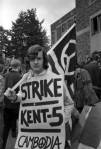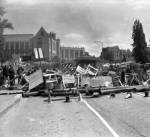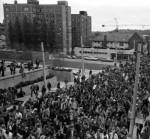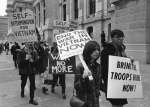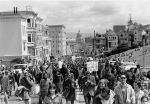1960- December 20th: The National Liberation Front is established. (Referred to as the Viet Cong by the U.S.)
1964- August 7th: The U.S. Congress approves the Gulf of Tonkin Resolution, giving President Lyndon B. Johnson authorization, without a formal declaration of war by Congress, for the use of “conventional” military force in Southeast Asia.
1965- March 8th: The first U.S. combat units arrive in Vietnam.
1968- January 30th: The Viet Cong and North Vietnam People’s Army of Vietnam launch a series of surprise attacks against military and civilian commands and control centers throughout South Vietnam (Tet Offensive).
1968- March 16th: American soldiers massacre hundreds of civilians in the hamlet of My Lai.
1968- April 3rd: Ho chi Minh’s government declares it is prepared to talk about peace and preliminary talks will begin in May.
1968- April 4th: Martin Luther King, Jr. is assassinated at the Lorraine Motel in Memphis, Tennessee.
1968- May 27th: In U.S. v. David Paul O’Brien, the U.S. Supreme Court rules that the criminal prohibition of draft card burning does not violate the First Amendment’s guarantee of free speech.
1968- November 6th: Nixon is elected president of the U.S.
1969-June: The number U.S. troops in Vietnam peaks at 543,000. Nixon announces his plan to train and transition South Vietnamese troops to assume roles filled by American troops. He promises to withdraw 25,000 American soldiers.
1969- September 3rd: Ho Chi Minh dies at the age of 79.
1969- November 15th: Around 600,000 Americans attend an anti-war protest rally in DC.
1969- November 16th: Nixon promises to withdraw 35,000 additional troops from the war in Vietnam.
1969- December 1st: The first draft lottery since 1942 was held in the U.S. The drawing determined the order of induction for men born between January 1, 1944 and December 31, 1950. A large glass container held 366 blue plastic balls containing every possible birth date and affecting men between 18 and 26 years old.

Rep. Alexander Pirnie, R-NY, draws the first capsule in the lottery drawing held on Dec. 1, 1969. The capsule contained the date, Sept. 14.
1969- December: Irwin tells his parents he was drafted into the Vietnam War
1969- December 15th: Nixon promises to bring home 50,000 troops from Vietnam by April 1970.
1970- February 20th: Secret peace talks between Henry Kissinger and North Vietnam begin in Paris.
1970- April: Over 420,000 American soldiers remain in Vietnam. Nixon promises to withdraw another 150,000 within the next year.
1970- April 30th: In a nationally televised broadcast, President Nixon announces that American and South Vietnamese units have invaded Cambodia to destroy bases that provided aid to the NLF.
1970- May 1st: Students at Kent State University in Ohio organize a massive public demonstration against the American invasion of Cambodia.
1970- May 4th: The Kent State shootings occurred at Kent State University in Kent, Ohio, in the United States and involved the shooting of unarmed college students by the Ohio National Guard.
1970- May 14th: Police shoot and kill 2 students during anti-war protests at the historically black Jackson State College in Mississippi.
1970- September 30th: Irwin arrives in Saigon.
1971- April: A military court sentences First Lieutenant William Calley to life in prison for the murders of 22 Vietnamese civilians in the My Lai Village in 1968.
1971- April 24th: 200,000 people march in DC to protest the Vietnam War.
1971- June 13th: The New York Times begins publishing pieces from the “Pentagon Papers,” which contain top-secret information collected by the Department of Defense about U.S. political and military involvement in Vietnam from 1945 to 1967.
1971- June: The House and Senate vote to withdraw all U.S. troops in Vietnam by year’s end.
1972- March 30th: President Nixon orders massive bombing of North Vietnam in response to a major attack (the Easter Offensive) launched by the NLF in South Vietnam
1972- August 11th: The last U.S. ground troops leave Vietnam. Thousands of airmen, advisors, and support personnel remain.
1972: October 11th: An agreement to end the Vietnam War is reached between Kissinger and North Vietnam.
1972- November 7th: Nixon defeats Democratic candidate Senator George Mcgovern in the presidential election. Mcgovern runs on an anti-war platform that would grant amnesty to draft evaders who left the county and would exchange American withdrawal from Vietnam for the return of American Prisoners of War.
presidential election. Mcgovern runs on an anti-war platform that would grant amnesty to draft evaders who left the county and would exchange American withdrawal from Vietnam for the return of American Prisoners of War.
1973- January 27th: Representatives from South Vietnam, North Vietnam, and the U.S. sign a peace agreement in which a ceasefire is declared, the U.S. agrees to withdraw combat troops and the government of South Vietnam promises to hold free elections to allow its people to decide their future.
1973- May 29th: U.S. Combat Units are withdrawn from Vietnam, but military advisors and some Marines remain. Over 3 million Americans have served in the war, nearly 60,000 are dead, 150,000 wounded, and at least 1,000 are missing in action.
1974- May: The ceasefire in Vietnam is officially over. The U.S. Congress rejects President Nixon’s request for increased military aid to South Vietnam.
1974- August 9th: President Nixon Resigns amidst the Watergate scandal; his vice president Gerald Ford takes office.
1975- April 30th: The North Vietnamese take Saigon; the war in Vietnam ends.





